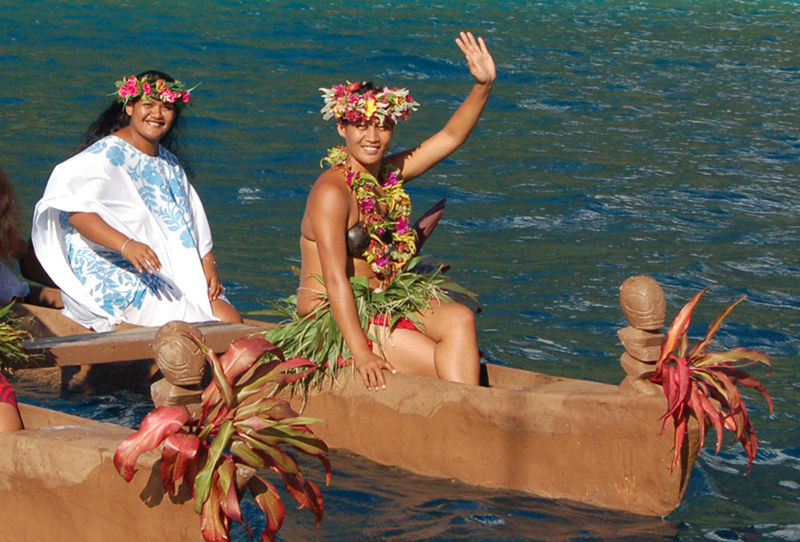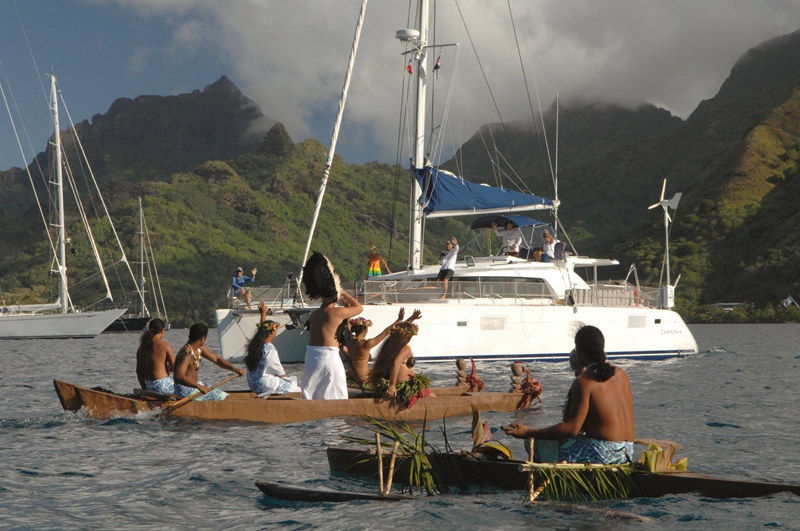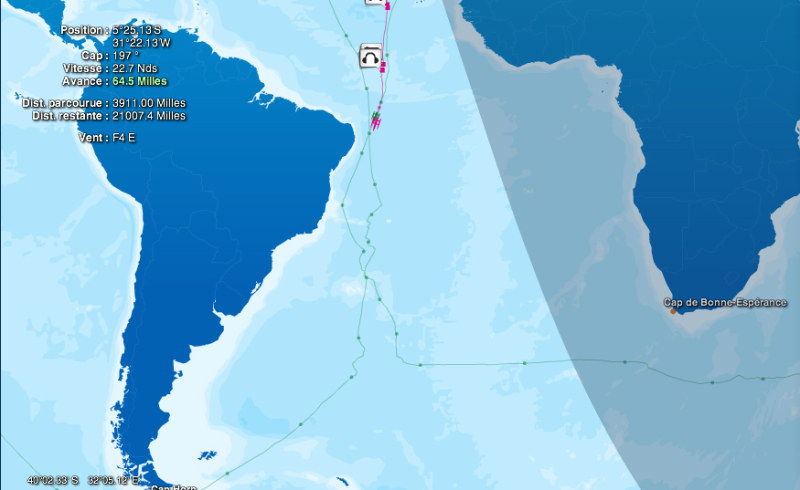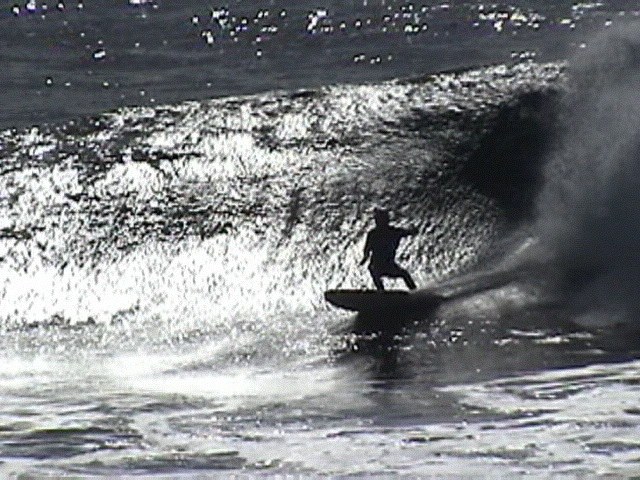
Bond Deal & Parties for Jumpers

© Latitude 38 Media, LLC
Veteran cruisers will tell you that the people of French Polynesia are among the friendliest folks in the South Pacific. Ironically, though, their government is the only one we know of that requires every arriving sailor with a non-EU passport to post a cash bond equal to the price of a plane ticket home — unless you have made special arrangements for a ‘bond exemption’.
We’ve been working for months with several Tahitian associates to facilitate a bond exemption for this year’s fleet, and we’re happy to report that the details have finally been worked out. The French Polynesian yacht and ship agency CMA CGM has offered a special deal to Pacific Puddle Jumpers who register for the rally at our site, which includes clearance in and out, bond exemptions for crew, and duty free fuel in the Marquesas and Tahiti (a savings of roughly $2/gallon).
Last year’s price of $110 per boat, offered by a different agency, proved to be more trouble than it was worth, and that agency did not renew their offer this year. CMA CGM’s offer is more expensive, but we feel it is still quite a good deal. Cost for two crew will be $188 USD (payable in advance via PayPal). Cost for four crew will be $222 USD. Puddle Jumpers may also use their services on an a la carte basis, such as individual bond exemptions for $67 per person. All other services are charged at $44/hour.
We’re delighted to extend CMA CGM’s offer to the fleet as most former cruisers consider the bond issue to be a substantial hassle. We should note, however, that fleet members are under no obligation to use CMA CGM’s services. And Latitude 38 is in no way involved with the financial dealings of this offer. Also, it is possible to avoid paying the bond if you have a return air ticket to your home country. Details of the ‘deal’ will be emailed to fleet members soon.

© Latitude 38 Media, LLC
The ‘bond deal’ news comes none too soon, as many boats along the west coast of the Americas are now making final preparations for departures in late February or early March. Latitude 38 will help usher them on their way with two Pacific Puddle Jump send-off parties in February:
February 4 — at the Vallarta YC, Nuevo Vallarta, Mexico (just outside PV), 2 – 5 p.m. Digital media presentation, free snacks and drinks, and Q & A on pertinent issues. All attendees will be interviewed for mini-bios in Latitude 38 magazine. Members of this year’s fleet only, please.
February 12 — at the Balboa YC, Balboa, Panama, 11 a.m. – 4 p.m. Cohosted by Latitude 38 and Tahiti Tourism. Digital media presentation, free snacks and drinks, and Q & A on pertinent issues. Open to all westbound cruisers.
If you’re in the Seattle area and are curious about the Puddle Jump, come see us at the Seattle Boat Show. We’ll be giving seminars both this Saturday (2 p.m. red stage) and Sunday (2 p.m. red stage). These presentations will immediately follow 1 p.m. seminars on the Baja Ha-Ha cruisers rally, from San Diego to Cabo San Lucas. Hope to see you at any or all of these events!
BP V Facing A Challenging South Atlantic

© Latitude 38 Media, LLC
A tricky crossing of the Pot au Noir that saw them temporarily fall behind the record pace has given way to champagne sailing for Pascal Bidégorry’s 131-ft trimaran Banque Populaire V. Recording the second fastest time to the Equator — 5d, 17h and 44m, an average of 25.9 knots — the big blue and white boat has a 65-mile lead over Groupama 3‘s ’10 time. But the next section of the course, from the Brazilian Coast to the Cape of Good Hope, will be a dogfight for the 14-man crew in their Jules Verne Record Attempt. The St. Helena High is elongated from east to west, and getting to the Southern Ocean may be a significant challenge.
“The situation is not very clear for now but we might have to go around the northern side of it, which would imply taking a big detour to reach Good Hope," Bidégorry said. "We are attentively looking at the satellite images received every hour. One certain thing is that we do not have a crystal ball to look into but we definitely won’t let any opportunity go, and make everything we can to increase our lead on the reference time."
Going over the top of the high could mean a big deficit against Groupama 3‘s time, as although Franck Cammas’ 105-ft tri was slowed by the High last year, it was able to get to the south along the more direct counter-clockwise route.
What’s With the Slow Ships?
If commercial shipping seems to be moving slower than last year, that’s because it is — and it’s due to the increasing cost of fuel. According to trade organizations, the 4,650 larger commercial ships of the world are now traveling at an average of 11.7 knots, about 7% slower than the year before. Oddly enough, this is said to be giving a kick to the shipbuilding industry.
Surfing Todos Santos
In Wednesday’s ‘Lectronic, we invited fellow surfer-sailors to share some of their favorite breaks (without giving away the location, of course). Kurt Roll, who crewed from Mexico to New Zealand aboard on Dietmar Petutschnig and Suzanne Dubose’s Las Vegas-based Lagoon 440 cat Carinthia, shared some of his Mexican surfing-sailing adventures:
"While getting Carinthia ready for the Puddle Jump in La Cruz, I regularly took the dinghy out to the point. It was a six-mile trip and my only complaint is that I was by myself surfing great waves.

"Here are some pictures of some surfing Todos Santos Island off Ensenada. I had my new Catalina 320 Pura Vida at the Corral Marina for the ’90 day yacht club’ in the winter of ’00. Each weekend I drove down and anchored in between the two islands. In late October, the waves would come in about 4-5 feet and were perfect. In November, the waves were more consistent, growing to 5-8 feet. By December, 8- to 12-ft sets were coming in, some bigger and some smaller. In January, it got out of hand but very exciting — two weekends in the 20-ft+ range!
.jpg)
"I quit after dropping in on a 15-18 footer. I made the bottom turn and then couldn’t outrun the lip on my nice Linden gun. I was held down for two waves and remember hearing the rocks clanking around on the bottom. After finally catching my breath, I was more than happy to film the ‘young guys’ eating it from my boat while enjoying a beer. It got to where the only ones making the waves were the tow-in guys. Watching these huge waves was mesmerizing and awe inspiring — I’ll never forget it.
.jpg)
"This was my 20th year racing the Newport to Ensenada Race. I always look at Todos and think of the amazing time I had out there. The hiking and kayaking there were awesome, too, as was trading beer for lobsters with the super-friendly fishermen. The lighthouse keeper lived out there with his German Shepherd and loved it when we brought Marlboros and goatsmilk caramel suckers. I can think of at least five other places in Mexico I’ve surfed while sailing but that’s another story."
